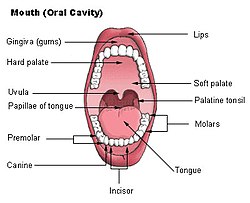Palatine tonsil
| Palatine tonsil | |
|---|---|

Mouth (oral cavity).
|
|

|
|
| Details | |
| Precursor | pharyngeal arches |
| System | Immune system (Lymphatic system) |
| Artery | tonsillar branch of the facial artery |
| Nerve | tonsillary branches of lesser palatine nerves |
| Identifiers | |
| Latin | tonsilla palatina |
| Dorlands /Elsevier |
12812446 |
| TA | A05.2.01.011 |
| FMA | 9610 |
|
Anatomical terminology
[]
|
|
Palatine tonsils, commonly called the tonsils and occasionally called the faucial tonsils, are tonsils located on the left and right sides at the back of the throat, which can often be seen as flesh-colored, pinkish lumps. Tonsils only present as "white lumps" if they are inflamed or infected with symptoms of exudates (pus drainage) and severe swelling.
Tonsillitis is an inflammation of the tonsils and will often, but not necessarily, cause a sore throat and fever. In chronic cases tonsillectomy may be indicated.
The palatine tonsils are located in the isthmus of the fauces, between the palatoglossal arch and the palatopharyngeal arch of the soft palate.
The palatine tonsil is one of the mucosa-associated lymphoid tissues (MALT), located at the entrance to the upper respiratory and gastrointestinal tracts to protect the body from the entry of exogenous material through mucosal sites. In consequence it is a site of, and potential focus for, infections, and is one of the chief immunocompetent tissues in the oropharynx. It forms part of the Waldeyer's ring, which comprises the adenoid, the paired tubal tonsils, the paired palatine tonsils and the lingual tonsils. From the pharyngeal side, they are covered with a stratified squamous epithelium, whereas a fibrous capsule links them to the wall of the pharynx. Through the capsule pass trabecules that contain small blood vessels, nerves and lymphatic vessels. These trabecules divide the tonsil into lobules.
...
Wikipedia
